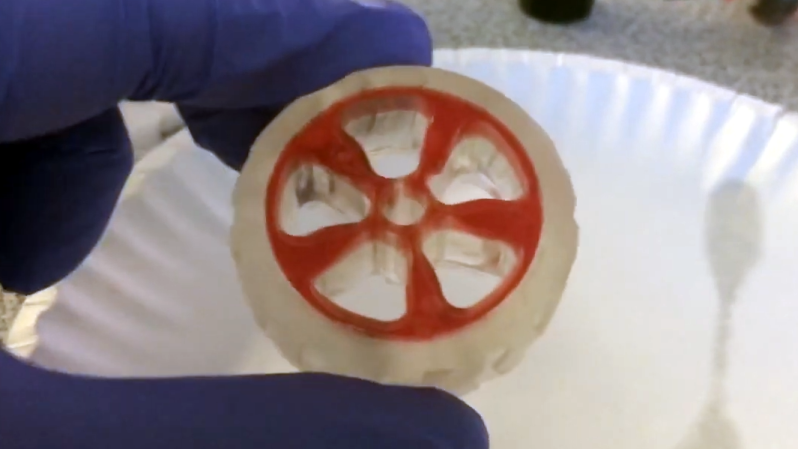Resin printing is a fantastic way to create parts, but multi-material printing isn’t really a possibility with resin. That is, unless you use [Cameron Coward]’s method for creating multi-material resin prints.
[Cameron]’s idea relies on the fact that handling and curing UV resin can easily be done outside of the printer itself. First, one prints what we’ll call the primary object. This object has empty spaces representing the secondary object. Once the primary object is printed and finished, these voids are carefully filled with a different resin, then cured with UV light. The end result is a single multi-material object that is, effectively, made from two different resins.
[Cameron] demonstrates this concept wonderfully by printing a wheel in clear, flexible resin. This wheel has a void in it where the hub would go, but instead of printing a hub and gluing it in, the hub-shaped void is carefully filled with a different resin. Exposing that added resin to UV light cures it and bonds it to the flexible wheel. The result? A one-piece wheel with a squishy tire and a rigid hub.
One shortcoming to this method is that UV has to be able to reach the added resin, so no filling of internal cavities where UV can’t shine directly on the liquid resin. Otherwise, it seems pretty flexible, and a good idea to keep in one’s mental toolbox. It’s also possible to work in stages, so complex shapes or large volumes don’t need to be done all at once.
There’s a short video embedded below that shows the whole process. Really helping this idea along is the fact that resin choices and properties are considerably wider and more varied than they were even just a few years ago, so whatever your needs, there’s probably a resin out there for it.





















Interesting approach… I would have gone for filling with polyurethane. No requirement for UV, and can be used in internal spaces too.
Good idea, casted urethane has good durability. I wonder if you can get it in a syringe.
Also the possibility of mixing some reinforcing fibres into the resin too for extra sttength.
Nice! And I can’t imagine a better way to demonstrate it! That was like, the ideal application!
It stands to reason that it’d also be possible to do something like print the wheel hub in rigid resin with a temporary tire mold that you then snap off after casting the tire in flexible material. 🤔
I wonder if there was any resin left in the nearby syringe that was hardened by stray UV.
There was resin left in the syringe, which I washed out with alcohol. But if anyone does this, they should probably just plan on throwing away the syringe (they’re cheap anyway).
I wonder if the part could be printed with internal channels, so resin could be injected throughout the part, perhaps like a bird bone like structure and a lightweight body material, so you can have high strength and rigidity.
That sounds like an amazing idea! Might be tricky, depending. At the very least you’d probably need to manually flush the uncured resin from the channels with a syringe of IPA before you cured the first material. I’m not sure your standard Wash & Cure setup’s wash cycle would get up in those sorts of nooks and crannies. (Hell, I’m not even sure an ultrasonic would totally do it.)
You could defiitely do that. I might try that this weekend.
It would be difficult to properly cure those channels, since the UV light wouldn’t reach it well. But I think it’d be doable with transparent resin.
There’s only one hub ? Is the other face squishy ?
At such sizes that seems pretty common – I assume because the squishy outer layer is so damn thin if its got a ridged skeleton all over you might as well just have made it solid one part as it can’t really deform enough to be useful anyway.
(Though obviously other material properties may also come into play – like coefficient of friction, its just not got any passive squashy suspension if its such a thin skim of something ‘soft’ over the solid)
It is for this demonstration, but it’d be easy enough to fill with rigid resin on both sides.
I want to do this but with conductive silver ink/paste and the process automated.
How do UV cured flexible resins compare to stuff like TPU / TPE? Few years ago the word on the street was that UV resins are brittle and they become even more brittle with time as the part is used and exposed to natural light. Even the “flexible” resins were getting hard (and brittle) after some time… Do we now have resins that will stay flexible after 15 years of use?